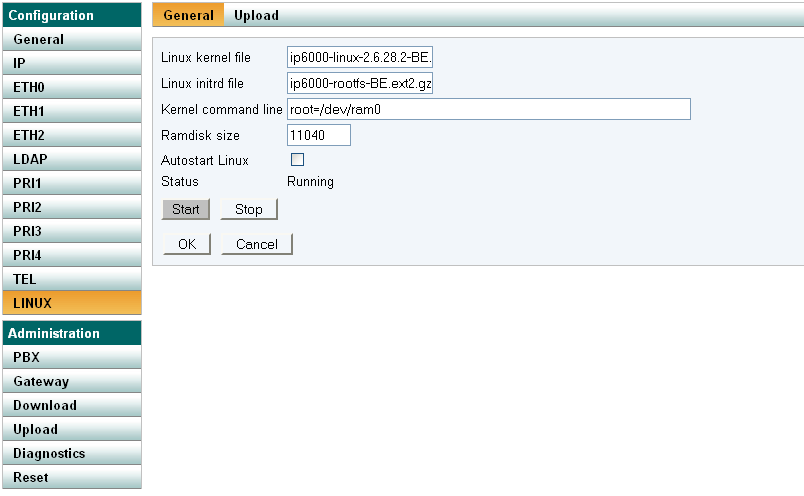Reference8:Configuration/LINUX/General: Difference between revisions
| Line 80: | Line 80: | ||
=== Copy Linux to the CF_Card === | === Copy Linux to the CF_Card === | ||
The | The root system shows a file system on the CF card. Linux will be started with the root file system in the RAM disk. | ||
With Telnet you can connect to the Linux system: | With Telnet you can connect to the Linux system: | ||
telnet 172.16.14.253 | telnet 172.16.14.253 | ||
| Line 93: | Line 92: | ||
su (no password) | su (no password) | ||
mount /dev/sda /mnt | mount /dev/sda /mnt | ||
cp /mnt/ | cp /mnt/ip6000-linux-2.6.28.2-BE.ext2.gz /tmp/ip6000-linux-2.6.28.2-BE.ext2.gz | ||
umount /dev/sda | umount /dev/sda | ||
| Line 100: | Line 99: | ||
fdisk /dev/sda | fdisk /dev/sda | ||
The first primary partition can be a WIN95 (LBA), the second a LINUX-partition. A Swap-partition will be initialized searched on the fourth position | The first primary partition can be a WIN95 (LBA), the second a LINUX-partition. A Swap-partition will be initialized searched on the fourth position. | ||
| Line 107: | Line 106: | ||
mkfs.ext2 /dev/sda2 | mkfs.ext2 /dev/sda2 | ||
gunzip /tmp/ | gunzip /tmp/ip6000-linux-2.6.28.2-BE.ext2.gz | ||
mkdir /tmp/root | mkdir /tmp/root | ||
mount /tmp/ | mount /tmp/ip6000-linux-2.6.28.2-BE.ext2 /tmp/root -o loop | ||
mount /dev/sda2 /mnt | mount /dev/sda2 /mnt | ||
cp -r /tmp/root /mnt | cp -r /tmp/root /mnt | ||
umount /tmp/ | umount /tmp/ip6000-linux-2.6.28.2-BE.ext2 | ||
umount /dev/sda2 | umount /dev/sda2 | ||
Revision as of 12:47, 16 November 2009
The fundamental operating modes of the LINUX are configured on this page. The Linux OS can be startet on selected platforms as a secondary operating system that runs application specific tasks. Linux and the innovaphone OS coexist on the device and share the resources like memory and cpu time.
Note: LINUX is only as Beta for experimental use at V8 available
Supported platforms
Linux is currently supported as a beta on the IP6000.
IP6000 little endian
Common linux distributions run in little endian, the IP6000 CPU usually runs in big endian. To support little endian linux a little endian IP6000 firmware is available. To install this firmware the LDAP directory and the VARS need to be changed to little endian format. The procedure to install the little endian IP6000 firmware version is:
- Backup configuration
- Install latest bootcode that allows to boot littleendian IP6000 firmware.
- Install latest IP6000 firmware that supports migration to littleendian
- clear the flash memory with http://addr/!mod+cmd+FLASHMAN0+reset+all+erase
- Upload the little endian firmware to DRAM ( ip6000-le.bin )
- Now the little endian code is running...
- Upload ip6000-le.bin to flash.
- Restore configuration
The Ip6000-le version has some restrictions: Bootcode update is not possible, Certificate key invalidation is not supported.
To install the big endian over the little endian version it is also needed to clear the flash, upload the bif endian version to DRAM, and then flash the big endian version.
Memory partitioning
The innovaphone OS can reserve memory for Linux. This is done with the commands
http://addr/!config+flags+L...
Configuration
Activate Linux-Support
Reservation of main-memory and switch on the linux-menu:
!config flags L !config write
Restart is needed.
ETH2 - virtual network connction for Linux
- DHCP: Mode Server
- IP: IP Address z.B. 172.16.14.253
- IP: IP Network Mask z.B 255.255.255.252
- IP: Proxy ARP enable, also for outgoing Network interface ETH0 or ETH1
- DHCP-Server: First Address & Last Address z.B. 172.16.14.254
- DHCP-Server: Network Mask 255.255.0.0
- DHCP-Server: Default Gateway 172.16.0.1
Start Linux
For starting Linux a Kernel Binary mus be uploaded or be provided via the CF card. Via the Kernel command line you tell the Kernel where the Root file system is. This can be uploaded or be available via the CF card. Will be used as temporary RAM-Disk, or as whole partition on the CF Card
Linux with Root-File-system starting ina a RAM-Disk
- Linux kernel file: e.g. ip6000-linux-2.6.28.2-BE.bin
- Linux initrd file: e.g. ip6000-rootfs-BE.ext2.gz
- Kernel command line: root=/dev/ram0
- Ramdisk size in kBytes: 11040
Linux with Root-File-system on the CF-Card
- Linux kernel file: e.g. ip6000-linux-2.6.28.2-BE.bin
- Linux initrd file:
- Kernel command line: root=/dev/sda2
- Ramdisk size in kBytes:
Copy Linux to the CF_Card
The root system shows a file system on the CF card. Linux will be started with the root file system in the RAM disk. With Telnet you can connect to the Linux system:
telnet 172.16.14.253
Loginname: default No password.
Mounting of the CF-Card and copy the data:
su (no password) mount /dev/sda /mnt cp /mnt/ip6000-linux-2.6.28.2-BE.ext2.gz /tmp/ip6000-linux-2.6.28.2-BE.ext2.gz umount /dev/sda
Build a partition on the CF-Card:
fdisk /dev/sda
The first primary partition can be a WIN95 (LBA), the second a LINUX-partition. A Swap-partition will be initialized searched on the fourth position.
Format partition, mounting and copy the Root-System:
mkfs.ext2 /dev/sda2 gunzip /tmp/ip6000-linux-2.6.28.2-BE.ext2.gz mkdir /tmp/root mount /tmp/ip6000-linux-2.6.28.2-BE.ext2 /tmp/root -o loop mount /dev/sda2 /mnt cp -r /tmp/root /mnt umount /tmp/ip6000-linux-2.6.28.2-BE.ext2 umount /dev/sda2
